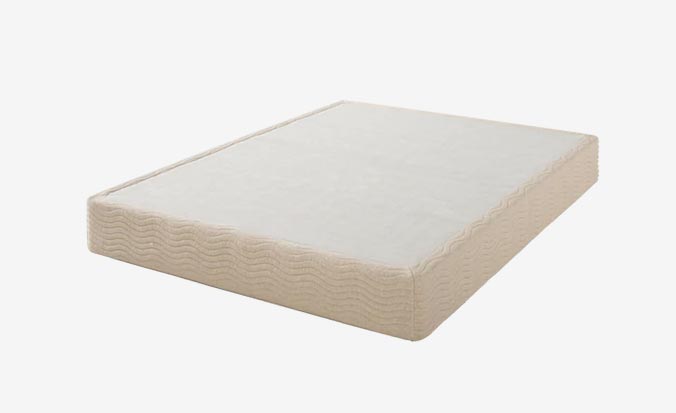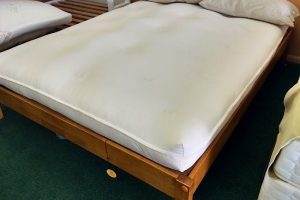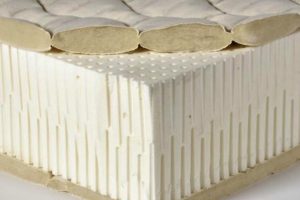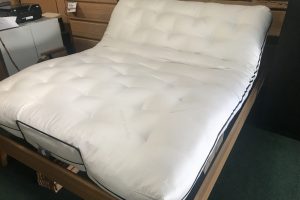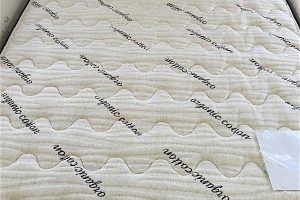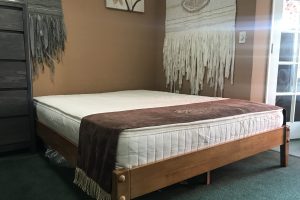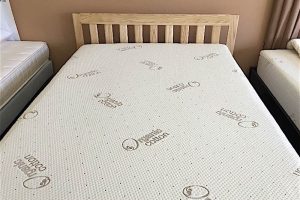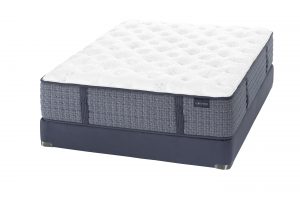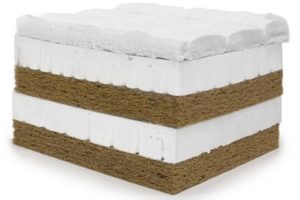- Mattresses
- Furniture
- Sleep Accessories
- Mattresses
- Furniture
- Sleep Accessories

- Mattresses
- Furniture
- Sleep Accessories
Chemical Free Mattresses
The Best Non Toxic Mattress
Disclaimer: GentleHome is supported by its readers. We may earn affiliate commissions through the links on our site. Learn more
Are You Really Sleeping As WELL As You Should Be?
Our Best Deals as of January 2024
Sleigh beds are the ultimate addition to any master bedroom. With its old copper finish and intricately detailed castings, it’s easy to see why this took two years of designing!
The industrial steel bed frame is sturdy and built to last, while the transparent finishing blends in with any décor. Available through our partner at Keetsa.com
This portable, collapsible base with a sleek design was invented for maximum comfort and is perfect for those who prefer to elevate their mattresses.
Shop Chemical Free Mattresses
Organic Latex Rubber, Wool & Organic Cotton Mattress
Organic Cotton & Wool Mattress: Chemical-Free, American Futon Style, Tufted Design. Ideal for Platform Beds, Box Foundations, or Bi-fold Frames
Organic Latex Rubber, Wool and Organic Cotton Mattress
Talmadge Natural Futon Mattress
Maya Natural Latex Mattress
Improve your sleep with this practical organic cotton, wool and latex mattress. High quality comfort meets eco-friendly durability.
Goldfinch Natural Latex Rubber and Coconut Mattress
Ethos Natural Talalay Latex Mattress
This premium all-natural chemical-free mattress with organic cotton has a balanced feel for a better night’s sleep.
Autumn Luxury Pillow Top Natural Latex Mattress
Goldfinch Natural Latex Rubber and Coconut Mattress
PalmPring Colva Queen Mattress- Floor Model Special
Floor Model Special
The Colva has two sides- one firm and one very firm! For those seeking the highest quality and long lasting eco-friendly bed that offers a comfortable, very firm feel.
Organic Chemical Free Mattress FAQs
Organic mattresses are worth it because they benefit people with chemical sensitivities, allergies, and anyone looking to create a healthier sleeping environment. Advantages include:
Comfort: Organic materials like natural latex and organic cotton offer excellent support and temperature regulation, enhancing sleep quality.
Healthier Sleep Environment: Free from harmful chemicals and toxins, reducing potential health risks like respiratory issues or skin irritation.
Hypoallergenic: Lower risk of allergies as these mattresses often resist dust mites, mold, and mildew.
Eco-Friendly: Made with sustainable materials and practices, reducing environmental impact.
Better Air Quality: Minimal off-gassing reduces exposure to volatile organic compounds (VOCs), promoting cleaner indoor air.
Durability: Often more durable than synthetic mattresses, providing long-term comfort and support.
The difference between an organic mattress and a regular mattress lies primarily in the materials used and manufacturing processes:
Materials:
- Organic Mattress: Made with natural materials like organic latex, organic cotton, and organic wool. These materials are grown or produced without synthetic pesticides, fertilizers, or genetically modified organisms (GMOs). Organic latex is made from the sap of rubber trees grown under organic farming practices.
- Regular Mattress: Made with synthetic materials like polyurethane foam, memory foam, or conventional innersprings. These materials include chemicals and are produced with industrial processes. Regular mattresses also use non-organic fibers like conventional cotton or synthetic blends.
Chemical Exposure:
- Organic Mattress: They are free from certain harmful chemicals and flame retardants, and have lower levels of volatile organic compounds (VOCs), leading to better indoor air quality and reduced potential for allergic reactions.
- Regular Mattress: Can contain chemicals used during manufacturing, like adhesives, flame retardants, and other treatments. These emit VOCs, affecting air quality and associated with health concerns.
Certifications:
- Organic Mattress: Comes with certifications like the Global Organic Textile Standard (GOTS) for organic fibers or the Global Organic Latex Standard (GOLS) for latex, ensuring they meet strict environmental and health standards.
- Regular Mattress: May have certifications, focusing on safety standards rather than organic or environmental criteria.
Sustainability:
- Organic Mattress: The production of organic mattresses follows more sustainable and eco-friendly practices.
- Regular Mattress: Sustainability depends on the materials and practices of the manufacturer but regular mattresses are less focused on eco-friendly practices.
Cost:
- Organic Mattress: Typically more expensive due to the higher cost of organic materials and more labor-intensive production processes.
- Regular Mattress: Usually less expensive, reflecting the lower cost of materials and more industrialized production methods.
A mattress categorized as organic implies a focus on natural, eco-friendly materials, and specific methods used in production, while offering a healthier sleeping environment with reduced environmental impact. These claims are verified through recognized certifications because the term “organic” can be used loosely in marketing.
Organic Materials:
- Natural Latex: Derived from the sap of organically grown rubber trees, without the use of synthetic pesticides or fertilizers.
- Organic Fibers: The use of organic cotton and wool, grown without harmful chemicals and processed without toxic dyes or treatments.
Certification Standards:
- Global Organic Latex Standard (GOLS): Certifies that the latex is organic, covering everything from the plantation where the rubber trees are grown to the processing and manufacturing of the latex.
- Global Organic Textile Standard (GOTS): Ensures that textiles used are organic, including ecological and social criteria in the certification process.
- Non-Toxic Fire Retardants: Instead of using chemical fire retardants, organic mattresses use natural materials like naturally fire-resistant wool, to meet fire safety standards.
- Sustainable and Ethical Manufacturing: Prioritizing environmentally responsible practices in the production process and ensuring fair labor practices.
- Low Chemical Emissions: Minimizing the use of volatile organic compounds (VOCs) and other harmful chemicals while contributing to better indoor air quality.
When selecting the safest organic mattress, focus on mattresses made with GOLS certified latex and GOTS certified cotton or wool. Choose natural fire retardants like wool or hydrated silica, avoiding chemical alternatives. Ensure the mattress has low VOC emissions, certified by GreenGuard Gold or OEKO-TEX Standard 100, and is hypoallergenic, resisting dust mites, mold, and mildew. Choose a brand that is transparent about its materials, and production processes, and adheres to ethical, sustainable practices. Make sure the mattress aligns with your personal health and allergy requirements.
The least toxic material for an organic mattress is natural latex, specifically, GOLS (Global Organic Latex Standard) certified latex. This certification ensures the latex is produced from the sap of organically grown rubber trees without the use of harmful pesticides or synthetic fertilizers, and that it’s processed in an environmentally friendly way. Natural latex is favored for its purity, durability, and comfort, and it does not emit significant levels of Volatile Organic Compounds (VOCs), making it a healthier choice for indoor air quality.
Other organic materials like GOTS (Global Organic Textile Standard) certified cotton and wool are also considered low toxicity. These are grown without toxic pesticides, synthetic fertilizers, or organic wool retardants. When used in combination with organic latex, GOTS contributes to creating a non-toxic, hypoallergenic, and environmentally friendly mattress.
The healthiest mattress combines organic materials (like natural latex, organic cotton, and wool), certifications such as GOLS and GOTS for quality assurance, hypoallergenic and antimicrobial properties, and is free from harmful chemicals and VOCs. It should offer proper spinal support, comfort, breathability, and durability. Personal health considerations, like allergies and sleeping habits, should also be considered, ensuring the mattress meets your sleep needs and preferences.
Non-organic mattresses can pose health and environmental risks due to the use of chemicals and materials in their production. They may off-gas Volatile Organic Compounds (VOCs), leading to potential respiratory irritation and other health issues. Chemical flame retardants used in these mattresses have been linked to hormonal disruption and developmental problems. Conventional cotton in non-organic mattresses, often treated with synthetic pesticides, can carry health risks, especially for sensitive individuals. Materials like polyurethane foam can degrade and release inhalable particles. These mattresses are less resistant to allergens like dust mites and mold, potentially exacerbating allergies, and have a higher environmental footprint due to non-biodegradable materials and energy-intensive manufacturing processes.
Avocado mattresses are marketed as non-toxic, using organic materials like GOLS certified latex and GOTS certified cotton, and are made from natural wool, free from harmful chemicals including formaldehyde. They avoid using toxic adhesives, using non-toxic or no-glue methods instead. Avocado mattresses have earned certifications like GREENGUARD Gold and MADE SAFE®, ensuring low chemical emissions.
Casper mattresses, designed to reduce harmful chemicals and emissions, are CertiPUR-US® certified, ensuring they are made without ozone depleters, heavy metals, formaldehyde, regulated phthalates, and have low VOC emissions. This certification confirms the absence of formaldehyde in the foam. For fire safety, Casper uses non-chemical methods like fire socks or fabric layers instead of chemical flame retardants. While there may be some initial VOC release, these odors are typically non-toxic and tend to diminish quickly, contributing to safer and more environmentally friendly sleeping.
Tempur-Pedic mattresses, certified by CertiPUR-US®, are made without ozone depleters, heavy metals, formaldehyde, and certain phthalates, ensuring low VOC emissions for better indoor air quality. This certification indicates Tempur-Pedic mattresses don’t contain formaldehyde. New Tempur-Pedic mattresses may off-gas initially, releasing a noticeable odor from VOCs, but this is considered non-toxic and diminishes over time. These features make Tempur-Pedic mattresses a choice with reduced harmful substances, suitable for most users, though those with specific sensitivities should still consider these factors.
Purple mattresses, which are CertiPUR-US® certified, are made without ozone depleters, heavy metals, formaldehyde, and certain phthalates, ensuring low VOC emissions. Their signature hyper-elastic polymer grid is a non-toxic material and less prone to off-gassing harmful chemicals. They use non-toxic fire retardants for safety compliance. Any initial odor from new Purple mattresses is typically non-toxic, associated with packaging rather than harmful off-gassing, and quickly dissipates. Overall, Purple mattresses are considered safe and non-toxic, suitable for most users.
Our Dedication To Your Comfort


Free nationwide shipping on selected items from our partners.


Our selected & reviewed organic mattresses are made from latex, cotton, wool and more!


What Clients Would Say About GentleHome
Shop By Room
Importance of Non Toxic Mattress
Do you ever…
- experience irritability or sleepiness in the day?
- encounter difficulties keeping from dozing whenever you sit still, watch T.V or read?
- drift into sleep or experiences tiredness as you drive?
- find it hard to concentrate?
- get comments about your looking tired?
- fail to react fast?
- find it hard to control your emotions?
- find yourself wanting to nap at all times
- need caffeine to stay alert?
If you answered “yes” to any of the previous questions, you may have a sleep disorder.
Your brain suffers all sorts of subtle damage with usage, and according to the Association of American Science, this damage is only repaired during sleep.
But it’s not just mere sleep that will suffice. You need deep Random Eye Movement sleep (REM).
One key factor is your mattress. You should use a mattress that is comfortable enough to get you into that deep REM state of sleep for sustained periods of time.
Apart from keeping you turning and tossing through the night due to poor support, heat retention and other unfavorable characteristics, most mattresses will in fact harm your health in the long run.
You may get joint pains, skin problems, and other sicknesses just from sleeping on the wrong kind of mattress.
In fact, according to the American Sleep Foundation, 45 percent of people living in the USA say they get poor or insufficient sleep.
A few developments have been made in the past decades for better sleep. And among the inventions that have been proved to give deep comfortable healthy sleep is organic latex mattress.
How Does Your Sleeping Position Affect Your Health?
To get the most health benefits out of your organic latex mattress, it’s important to know how your sleeping position impacts your well being.
What’s the effect of sleeping on your side with Arms at your side?
While sleeping on the back has been proved to be a good position as far as spine and neck health go, it may result in more snoring and sleep apnea which may lead to lower sleep quality.
What’s the effect of sleeping on your back, arms thrown upwards?
This position comes with the same benefits as sleeping on your back, with arms positioned by your side.
These include reduced back and neck pain and a lower rate of skin wrinkling. Likewise, it comes with the same disadvantage of snoring and sleep apnea. There is also a risk of shoulder pain since the nerves in the shoulders will be under pressure.
How does sleeping face down affect your health?
You can get better digestion by sleeping face down. However, breathing becomes a difficult task unless you tilt your face, which in turn might cause neck pain.
Other than that, your spine might suffer since there’s nothing to support its curvature.
What’s the effect of sleeping in the fetal Position?
The fetal position is great if snoring is a problem or you’re pregnant. Although this is a comfortable position, the acute curve you make makes it difficult to take a deep breath. There is also high risk for back pain.
What’s the impact of sleeping on your side with arms at your sides?
This position has the benefit of reduced neck and back pain. That’s because it allows the spine to maintain its natural shape. However, your skin wrinkling and breast sagging is sped up in this posture.
What effect will sleeping on the side with arms out have on your health?
You get the same benefits with sleeping like this as you do with your arms at your side. However, there is increased risk of constricting your blood vessels and nerves in your arms. This can be comfortable and may result in lower sleep quality.
What are the effects of sleeping on the right side?
Sleeping on the side has different effects depending on whether you’re on the left or right side. By sleeping on the right, you reduce the pressure on your internal organs like stomach and liver but this increases acid reflux.
If you are pregnant, it is advisable to sleep on the left as this increases blood flow to the fetus.
What about putting pillows under the body?
Pillows can help you sleep better in whatever position you might be lying. If you sleep on your back, you can get more comfort by putting a small pillow under the arch of your spine. If you are a side sleeper, a pillow under the knees is a great way to improve the quality of your sleep.
For stomach sleepers, a pillow under the hip will give you a comfy night.
What Is Natural Latex Rubber Mattress?
Natural latex rubber mattress is made from the juice of rubber trees, which are scientifically called hevea brasiliensis. These were naturally found in the Amazon region but were distributed to different parts of the world within 10 degrees north and south of the equator. Brazil used to be the biggest producer of rubber, but today, Thailand, Malaysia, and Indonesia have taken the mantle.
The tree takes 5 to 7 years to mature, after which the harvesting can begin.
Afterwards, the trees are allowed to revive from the draining and no harm is done to them in the long run. Sap harvesting can continue on the same trees for 30 years.
Once the rubber is collected from individual trees, it is poured into large containers to filter out any impure particles. The sap is then put into big molds to be turned into a flexible solid material, in a process called vulcanization.
There are two methods of vulcanization used. The first one, the older one, is the Dunlop method, while the other is the Talalay method. These have different effects on the texture, density, and general comfort of the final product even though they use the same materials.
Dunlop Method
The Dunlop method of latex rubber mattress production was developed over 60 years ago by the Dunlop Corporation.
Once the sap is collected, it is turned into a froth then placed in large molds of steam to be baked into latex rubber sheets. The method is used to produce firm, dense, and supportive latex mattress which is great for bottom layering.
But because some deposits in the sap collect at the bottom of the mold, the Dunlop organic latex mattresses will have more firmness toward the bottom. Its density is generally varied throughout the mattress mass.
Talalay Method
The Talalay method is the same as the Dunlop type but it goes two more processes further, which alter the physical properties of the final latex mattress.
After pouring the sap into the mold, it is air-sealed and placed in a vacuum. The sap is then subjected to low temperatures and within a short time, it freezes rapidly.
Afterward, the sap is baked to make latex rubber sheets.This causes the resulting latex mattress to have a consistent and airy texture.
It is generally more comfortable than Dunlop mattress and may be used to make toppings over firmer, less comfortable bases.
Why Choose Organic Latex Mattress?
Once you experience both of the worlds, that is the all natural latex mattresses and the synthetic ones, the difference is not hard to tell and the benefits of organic mattress go as far as health.
Here are 6 reasons why organic latex rubber mattress should adorn your bedroom.
1. It Has a Firm but Reactive Feel
Natural latex mattress comes with an elastic feel which makes it respond to your body’s pressure. The body is hardly straight, with an s-shaped spine. This makes it uncomfortable to sleep on a hard surface that won’t accommodate the body’s irregularities.
But if it gets too soft, you will have another problem.
Organic mattresses happen to have just the right firmness to support your body while being soft enough to accommodate its shape.
It is bouncy and has a highly adaptive nature which makes sleeping in different positions comfortable.
2. It Resists Mites
Mites can be a nasty nuisance but thanks to certain special organic properties, natural latex mattresses are resistant to the tiny creatures.
Most mattresses easily retain heat which makes them the perfect home for mites to live and breed in.
Organic latex, on the other hand, allows heat to escape because of its airy nature. This makes the mattress less habitable to mites than the synthetic type.
Secondly, truly organic latex mattresses have a low P.H., creating an acidic environment which mites cannot survive in. There are also some unconfirmed studies which purport that organic mattresses give off a smell which humans cannot detect but dust mite can. This smell is said to be repellent to the organisms, keeping them at bay.
3. It’s Good For Those With Hypersensitivity
Synthetic mattresses are known to cause different health problems due to the chemicals used in their making.
One benefit of natural rubber latex is its friendliness to people with hypersensitivity. Whether you have skin sensitivity or susceptibility to toxic smells from chemicals found in synthetic mattresses, natural rubber mattresses provide a better option.
But one area where natural latex mattresses shine is in their ability to prevent allergic reactions. Dust mites can cause different protein particles to accumulate in the mattress.
Sometimes you may notice the weight of your mattress double after some years. These particles include live mites, dead mites, and their fecal matter.
These are essentially protein in nature and when your body is exposed to them, they can trigger different allergic reactions, from mild skin itches to dangerous asthmatic attacks.
4. Easy to Change Position Without Disturbing Sleep
One reason some mattresses may give you body pains after a troublesome night sleep is that they make it difficult to roll.
Sleeping in the same position may constrict blood vessels and disrupt nerve cell communication. To avoid this, the body automatically rolls from side to side, belly to back, and any position change that may be necessary.
If your mattress is too soft, you may find it difficult to turn and will have your sleep interrupted every time your body tries to get into a fresh position.
The buoyant properties of natural latex rubber mattress make it easy to roll without snapping you from your REM (Random Eye Movement) sleep. It reduces the intensity of pressure on certain points in the body, distributing it evenly on the bed to give you more comfortable sleep.
5. It is Good For The Environment
If you haven’t been living under a rock, then you must have caught the buzz about using environmentally friendly products. When it comes to the bedroom, green mattresses might as well be the best way to show your support for the environmental movement.
They’re sustainable and do not harm the environment in their production or disposal. Of course, not all mattresses presented as green are indeed so. Some have synthetic components but we’ll get to that later.
6. You Can Better General Health
By using natural latex rubber mattresses, you can improve your health generally. It’s not just about healthy sleep patterns. For example, pure latex is good for people suffering from asthma because certain of its properties are harmful to microbes and bacteria. Not only does it not cause allergies, but it actually prevents them since it hypoallergenic.
What Should You Watch Out For When Buying an Organic Rubber Mattress?
As with many things, the untrained mattress shopper can easily get duped into thinking they are buying the real thing, when in fact what they getting is only organic by a fraction. Very few companies are making completely organic latex mattresses for the market.
The problem is that the term ‘latex’ can be used to refer to original rubber or the synthetic type. An organic mattress company may even have a ‘Green’ label just because the mattress has some natural rubber in it, enough to qualify for the badge.
The two types of mattresses are both called latex simply because the synthetic material was made to have the same properties as the natural type. In reality, the two materials are different as far as physical characteristics go.
Natural latex is expensive to make compared to the synthetic type which uses petrochemicals. The life spans are also significantly different. Artificial latex does not last as long as the organic type, and is also prone to forming cracks, piles, ruts, dips, and body contours.
The problem is that a combination of as little as 30% truly organic latex and 70% synthetic rubber is enough for manufacturers to call their mattresses natural. As a buyer, you end up with a product that has few organic properties and more synthetic characteristics.
Info: How Is the Mattress Held Together?
Mattresses are not always made as one block. They are sometimes smaller pieces held together, and this is one way the organic quality of your mattress may be reduced. Some mattresses are hand stitched but that takes time and may therefore be expensive.
To get around this, manufacturers often use toxic glue to hold the mattress parts together. This glue, though little, may be enough to bring you serious health problems after prolonged usage.
Info: What About Perimeter Support?
If you are looking for completely organic mattresses, you should be careful with those that put perimeter support around the beds. These may be hedgings of synthetic material, mostly polyurethane foam that is attached around the mattress to make the edges retain their shape.
The problem is that these may cause the same health issues you might be running from by choosing to buy an organic mattress. The best organic mattresses are those that come with all natural components.
Problems You Might Face While Buying Organic Mattresses
Inconvenient To Buy: One problem with organic mattresses lies in how inconvenient it can sometimes be to find truly natural mattresses. Organic mattress in San Diego and some places in the USA might be easy to find.However there are generally very few shops that stock organic beds, particularly in brick and mortar stores.
You can get some brands over the internet but if you do not live in a big metro area, it will be hard for you to test different organic latex beds before buying.
You can however have the luxury of returning or exchanging your mattress with some shops, in case you are not happy with your purchase.
Fewer Options: Opting for organic latex mattresses might also leave you with fewer options that you can choose from compared to other types. You are basically limited to latex foam beds, futon-style wool-stuffed beds, and spring mattresses with organic latex topping.
Buying Is More Complex: Another drawback has to do with the complexity of buying a good natural latex mattress. You need to have some experience with mattresses or at least buying organic products. If not, shopping for a pure latex mattress can be a confusing ordeal.
There is quite a number of terminologies that may leave you feeling lost. For example, you may come across manufacturers that advertise their mattresses as organic, but only because they come with organic covers and synthetic interiors.
You may also be given insufficient or simply false information like phony certifications and fabricated scientific claims, just to make you part with your money for an artificial bed.
How to Get Around The Problems?
The best way to dodge these bullets is to get as much information as you can about not just the mattress as a whole, but all the individual components as well.
For example, a mattress might have organic cotton. But sometimes manufacturers use toxic chemicals to make it resistant to fire.
Find out what the certification status is, and most importantly who issued the certification. You can run to the internet for this where you will be able to find different brands, natural mattress reviews, and certifying bodies. This might seem time-consuming but getting the most value for your money is worth every second of it.
Try to buy from reputable sellers. They must have easy-to-access third party feedback for you to understand what sort of company you might be dealing with. An organic bed is supposed to last years. Make sure you do the buying right.
Price: The high latex mattress prices might also be looked at as a drawback when it comes to shopping for organic mattresses. They generally take more time to produce and use more expensive materials. Your one chance, again, is research. Check around websites to find the best deal you can.
Try to find a dealer that is brave enough to give you a solid warranty, perhaps with the possibility of getting a replacement up to a few years. If the organic mattress store is any reputable, they should be able to stand behind their product.
Firmness: Apart from being heavy, organic mattresses can in some rare cases be too firm. This again is not a problem worth paying attention to as it certainly goes away within the first few weeks of use. If you feel this might bother you, then check the Load Deflection Information when buying your mattress to have a fuller idea about what you are getting.
A high IDL implies a firm mattress while a softer one is shown by a low ILD.
Why Organic Crib Latex For Your Baby?
Apart from all the discussed benefits of organic mattresses, you might especially want to go all natural on your baby’s crib mattress.
That’s because synthetic latex comes with all sorts of toxic chemicals.
The horde of harmful chemicals includes antimony compounds and arsenic. They are mostly added to make the mattress last longer and act as fire retardants.
But these chemicals may interact to give off phosphine, arsine, and stibine, which are all potent toxic nerve gases. Once in the baby’s system, they can wreck havoc to their heart, leading to cardiac failure.
You also need to pay attention to the material used in making the mattress wrapper. Its potential to harm your infant’s health is significant. In fact, some legislations like Florida have banned the use of certain materials for crib mattress covers. The most notable one is phthalates.
This is a substance commonly found in vinyl crib mattress covers, and it causes a range of health issues in children.
Latex Mattress vs. Memory Foam Mattress
Memory foam has been the rave in the past years. Should you choose it over organic latex?
Memory foam was developed by NASA for astronauts coming back home recently returned from the International Space Station. It is able to respond to heat generated under pressure from the body, making it extra comfortable to sleep on. The result is a mattress that prevents and even alleviates joint and muscle pain, In some cases.
The problem is that memory foam is made from synthetic materials and is loaded with toxic chemicals. It is a good mattress for comfort but may not be the best option if you have allergies. Some people report headaches, eye problems, and respiratory issues.
Organic latex, on the other hand, may be less comfortable than memory foam is also very comfortable and conforming to the body, even though it does not have a “Memory”, or slow recovery. When you change position, it immediately returns to its original shape, rather than slowly recovering. Its firmness tends to increase the more natural it is.
What Are The Types Of Latex Mattresses You Can Buy?
You have the option to buy three types of latex mattresses:
1. Organic Latex Mattresses
These are the most costly latex mattresses on the market. You can buy them at a price ranging from $2000 to $6000. While this is more expensive than synthetic blended latex, the durability and comfort you’ll get are definitely worth the price.
Natural latex is different from the synthetic type. It does not put your health at risk with toxic gas emissions as does synthetic mattresses. This makes it the healthiest option you can get your family.
Organic mattresses are completely biodegradable. It has no added petroleum which makes it good for the environment.
2. Synthetic Latex Mattresses
You may have to easily spend from $600 to $6000 to get a synthetic mattress. The price depends on the ratio of synthetic to natural polymers.
The cheaper one may have no organic latex at all, while those on the expensive end may have as much as 60% natural latex.
The blended mattresses that contain both synthetic and natural latex polymers are called Talalay latex mattresses. They have a poorer quality than organic mattress, but still retain similar benefits and aren’t harmful to your health.
3. Hybrid Latex Mattresses
Hybrid latex beds have sheets of organic latex on top of synthetic foam. They may sometimes have an innerspring core. While their prices range from low to high, they are less beneficial than organic mattresses in that they are less durable and can be less comfortable than the 100% natural latex.
Comfort Options for Latex Mattresses
Everyone has their preferences when it comes to how firm their mattress must be. You can choose from:
1. Ultra Plush: Identified as soft, soft with Medium Support.
2. Plush: Identified as soft, medium with medium support
3. Cushioned: Identified as soft, medium with firm support
4. Firm Cushioned: Identified as medium, medium, with firm support
5. Firmest: medium, firm, with firm support.
Frequently Asked Questions
1. What can I do to make latex beds last longer?
- Make sure your latex bed is well supported. To achieve this, use solid box springs.
- Keep flipping your mattress at intervals of 6 months to distribute wear and tear.
- Report any premature sagging to your manufacturer. Normally, your latex bed should go up to 20 years intact.
2. Can my latex foam work with electric blankets?
- Thick, warm blankets or electric blankets work great with them in winter, and light, airy blankets work with latex mattresses well in summer.
3. What are the advantages to using latex beds?
- Latex beds are resistant to mites and mould which may cause allergic reactions to susceptible people.
- Organic latex can conform to the shape of your body. This makes sleeping more comfortable by relieving pressure to the neck, back, and shoulders.
- Natural latex has just the right balance of firmness and softness to be comfortable for those who can’t use mattresses that are too soft.
4. Can weight gain be avoided with latex foam products?
- A lot of things lead to obesity. Among them is stress that may result from sleeping in an unconducive environment.
- Using latex mattress can at least make sure you do not gain weight due to stressful and sleepless nights.
5. How can a latex mattress help insomnia?
- The optimum firmness of organic latex, its lack of smell from toxic chemicals, and absence of bothersome allergens make it a good remedy for insomnia.
6. Do organic mattresses reduce fatigue?
- Fatigue can be caused by a number things including hurting muscles and joints.
- Since organic beds distribute your body’s weight evenly on the bed, they are good at alleviating muscle and joint pain.
7. Does organic latex hold more heat?
- Organic latex is good for retaining warmth.
- However, since the material is breathable, the heat does not concentrate under the body to become uncomfortable as with synthetic mattresses.
8. Are there any allergies that can come from natural latex?
- In most cases where people report latex allergies, it is the touching of latex to the skin that causes the problem. In the case of our latex mattresses, you are never touching the latex. In rare, extreme cases, just being in the vicinity of latex can cause a problem. I have never had this issue with a customer, but one needs to check with their doctor to see if this might be an issue
- But there is a difference between the latex found in organic beds and the one in things like surgical gloves. However, you have to consult your doctor to verify.
9. Should I choose organic latex or memory foam?
- Memory foam is synthetic and may come with different allergens.
- However, it is good if you are already having neck and back problems.
- Organic mattress is great for healthy sleep since it does not come with toxic chemicals. It is also great if you want to prevent back and neck problems.
10. What should I look for when buying latex beds?
- Try out the mattress before buying. Some are made with too much padding and this can make them too soft if you like a firmer bed.
- Read other people’s reviews on the manufacture of the mattress you’re trying to get. Some mattresses come with a number of problems like easy wear.
- Verify if the mattress comes with a warranty from the manufacturer. This will enable you to return it if it sags in a short time.
Disclaimer: All prices & products are subject to change and are only estimates. Products might not be available or sold out.
© 2024 Blue Media Marketing, Inc. | All Rights Reserved


